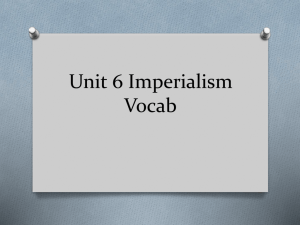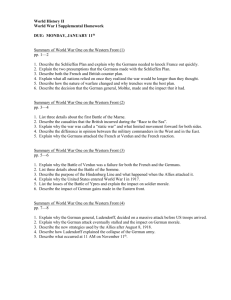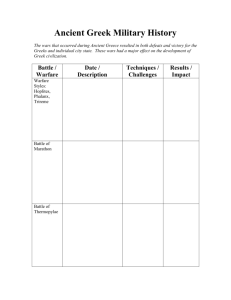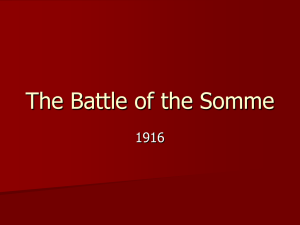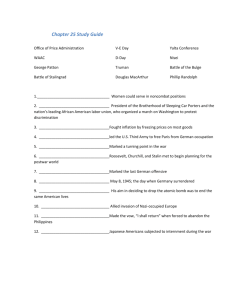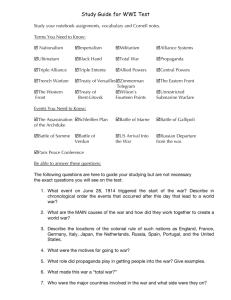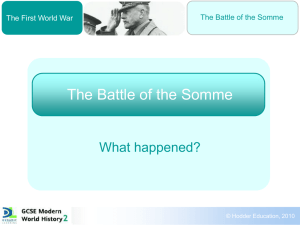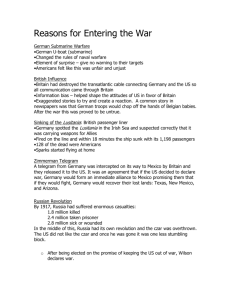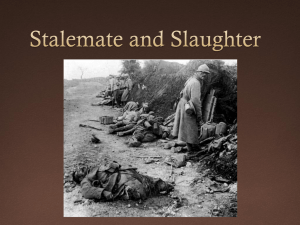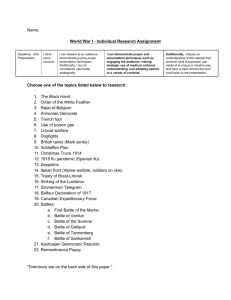File
advertisement
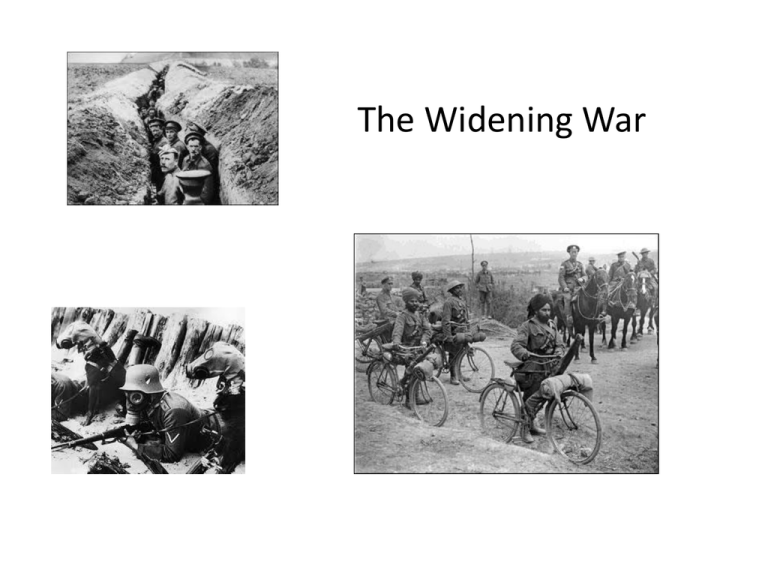
The Widening War The Western Front ”a jolly little war” ”the boys will be home by Christmas” • Schlieffen plan fails. Why? 1. More Belgian resistance than expected. 2. Russian attacks in east earlier than expected 3. Underestimated GB – Belgian alliance. 4. French forces transferred quicker than expected from Alsace-Lorraine. 5. Logistical problems – long supply lines 6. Diversion of German First Army to the southeast split her forces in two, increasing vulnerability. War of Attrition • September 1914 - German advance is halted at Battle of the Marne, 40 miles from Paris. Stalemate ensued. Taxicabs rush French and British forces to battle. • • • Ypres, Belgium: four major battles during the ”race to the sea”. February 1916 – Germans attempt to break stalemate at Battle of Verdun. No change in position. Nearly ½ million dead on both sides. July 1916 – Battle of the Somme. A pyrrhic victory for the allies. Only a few square miles gained. 600,000 dead. The Eastern Front • Germany inflicts major defeat on the Russians at Battle of Tannenberg and Battle of Masurian Lakes in August and September 1914. • Battle of Galicia 1914: Early victory for Russians over Austria-Hungary, but in May following year are pushed out by German offensive. • On Austrian front - Serbia humiliates A-H twice. Need Germany’s help to push back Russians. • By 1915 Russian’s advance is severely weakened. 2.5 million Russians are killed, wounded or captured in 1915. • Eastern Front is thereafter determined by the Germans. • May 1916 last Russian offensive against A-H; Russian army collapses in 1917 due to revolution. Also in 1915 • Italy changes sides. Joins the Entente with hopes to gain territory from Austria. Italy remains bogged down in South Tyrol for next 2½ years. Both sides suffer enormous losses. Italy is finally defeated in Battle of Caporetto 1917. • Bulgaria chooses to side with the Ottomans in order to settle scores with Serbia. • Disaster for Serbia: German and A-H attack from the north. Bulgaria from the south-east. The Serbian army, its monarchy and many of its people flee over the mountains to Albania. Ottoman Turks join war 1914 • • • War is extended to the Middle East. Allied with Germany and A-H, they hope to restore empire. Battle lines seesaw back and forth between Turks and Russians. • Britain doesn’t regard the Ottoman Empire as a serious opponent. • 1915 British invasion of Gallipoli. Aim is to take the Dardenelles and Constantinople. – French, British, Irish and Anzac (Australia New Zealand Army Corp) contingents are dealt severe defeat. Evacuation one year later. – First Lord of the Admiralty, Winston Churchill, was dismissed. A two-front war for Britain • Second struggle between the British and the Turks takes place in Mesopotamia. • Aim is to control oil fields which GB accomplishes already in 1914. • British advances up the Tigris and Euphrates Rivers are halted 20 miles from Baghdad where the Turks force them to retreat. British troops under siege for 5 months and they surrender in April 1916. • Heavy blow for Great Britain. Global warfare due to colonies • British hope to lead Arab revolts against the Turks. • British armies with contingents from Egypt, India, Australia and New Zealand fight the Ottoman Turks. • Colonial subjects of British and French supported their foreign masters. Helped to seize Germany’s colonies. • Japan seizes German colonies in the Pacific and on Chinese mainland. • More than 1 million Africans served in the various armies. Here is a picture of two African soldiers in France. The war at sea • Ambitions to control the world’s waterways were significant reasons that the war spread so quickly. • Mines, submarines, torpedoes made great warships vulnerable. • Naval power used to maintain control of trade routes around the globe. Submarine warfare • Britain and France naval blockade of Germany early in war. No neutral ship allowed to sail to Germany with cargo. • Germany launched counter-blockade with its new weapon – the submarine. • 1915 sinking of British passenger ship the Lusitania. USA, under Woodrow Wilson, protests. • Germany relaxes its submarine warfare. German domestic situation 1916 • Germany realizes that military success alone cannot win the war. Full mobilization of homefront. • 1916 Socialist opposition in Germany starts to press for compromise peace. • In November/December 1916 President Wilson tries to broker a diplomatic solution. Germany positive but France and England reject initiative. • German high command under Generals von Hindenburg and Ludendorff are determined to gain victories before peace. Want hegemony in Europe. Unrestricted submarine warfare draws US into war • Germany launches unrestricted submarine warfare at end of 1916. Sink all ships providing aid to the Allies. • USA is neutral but supplies GB and France. • Germany hopes that they can knock out Britain and France before the US can mobilize. • Zimmermann telegram February 1917 shifts public opinion away from isolationism. • USA declares war on Germany in April 1917. First combat in Europe with Americans starts in November. Beginning of the end • War weariness among soldiers and civilians. • Italian and Russian armies collapse in 1917. Strikes common in German cities. German moderates in Reichstag call for peace without territorial gains! • German High Command under Ludendorff push for one last great offensive in France. • March – July 1918 Second Battle of the Marne. Allies hold firm. • Submarine warfare fails. US troops and supplies crossing Atlantic tip the scales in favor of Allied victory Armistice (suspension of hostilities) • August 1918 – Ludendorff approaches Wilson for lenient armistice terms. Rejected by the Allies. Demand complete surrender and overthrow of monarchy. Negotiations over armistice drag on…. • German people rise up, army discipline collapses. Revolutionary councils of soldiers and workers appear. Kaiser Wilhelm II abdicates. A-H surrenders • November 9, 1918 A republic is proclaimed in Berlin and its leaders agree to armistice terms. Goes into effect on November 11, 1918.
